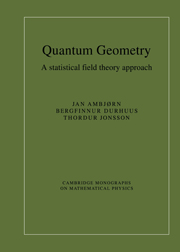6 - Gravity in higher dimensions
Published online by Cambridge University Press: 20 October 2009
Summary
In this chapter we return to the discussion of quantum gravity which we began in Chapter 4. In the first section we describe some of the technical problems that are encountered in constructing a theory of quantum gravity and some of the ideas that may go into their resolution. We then give a definition of simplicial gravity in arbitrary dimensions and describe a representative sample of the numerical results that have been obtained. It is often convenient to consider the theory in a fixed dimension larger than two. We shall discuss the four-dimensional case since it is physically the most relevant, and will only occasionally consider three-dimensional gravity.
Basic problems in quantum gravity
Formulating a theory of quantum gravity in dimensions higher than two leads to a number of basic questions, some of which go beyond those encountered in dimension two. Among these are the following:
(i) What are the implications of the unboundedness from below of the Einstein–Hilbert action?
(ii) Is the non-renormalizability of the gravitational coupling a genuine obstacle to making sense of quantum gravity?
(iii) What is the relation between Euclidean and Lorentzian signatures and do there exist analogues of the Osterwalder–Schrader axioms allowing analytic continuation from Euclidean space to Lorentzian space-time?
(iv) What is the role of topology in view, for instance, of the fact that higher-dimensional topologies cannot be classified?
We do not have answers to these questions and our inability to deal with them may be an indication that there exists no theory of Euclidean quantum gravity in four dimensions or, possibly, that quantum gravity only makes sense when embedded in a larger theory such as string theory.
- Type
- Chapter
- Information
- Quantum GeometryA Statistical Field Theory Approach, pp. 271 - 296Publisher: Cambridge University PressPrint publication year: 1997



